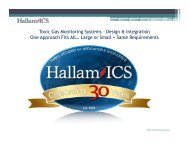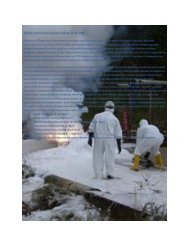SESHA 2011 Program Book - Semiconductor Safety Association
SESHA 2011 Program Book - Semiconductor Safety Association
SESHA 2011 Program Book - Semiconductor Safety Association
You also want an ePaper? Increase the reach of your titles
YUMPU automatically turns print PDFs into web optimized ePapers that Google loves.
Professional Development Courses<br />
Monday 16 May - Friday 20 May<br />
Monday 16 May<br />
Full Day, 8:00 am – 5:00 pm<br />
PDC1 Fundamentals and ESH Challenges of<br />
<strong>Semiconductor</strong> Manufacturing - Sonora A<br />
Susan Creighton<br />
The <strong>2011</strong> Introduction to <strong>Semiconductor</strong> ESH<br />
class is intended for ESH students and professionals<br />
new to the semiconductor industry and operations. Topics<br />
covered in the class include: •An overview of the<br />
semiconductor industry and operations •A virtual tour<br />
of a semiconductor fab •An introduction to the semiconductor<br />
manufacturing process •A presentation on occupational<br />
health and safety issues in a semiconductor<br />
fab •A review of semiconductor environmental considerations<br />
•Discussions on SEMI EHS Standards: S2, S8<br />
and S23 •A summary of global environmental regulations.<br />
An experienced semiconductor EHS professional<br />
recognized in their area of expertise presents each topic.<br />
This will be a full day PDC. Students will be provided<br />
with handouts of each presentation.<br />
3<br />
Half Day, 8:00 am - Noon<br />
PDC2 Vacuum and Cryogen <strong>Safety</strong> Concerns<br />
for Laboratory Applications - Sonora B<br />
Roger Shrouf<br />
Vacuum systems can present a variety of hazards<br />
to the laboratory worker. This course will provide an indepth<br />
discussion of a wide variety of hazards and mitigation<br />
techniques related to vacuum systems in a research<br />
laboratory environment. A thorough discussion of the<br />
interface between the vacuum system and commonly<br />
associated pressure sources (such as backfill or process<br />
gases) will be provided. The limitations and safety<br />
concerns associated with vacuum purging of associated<br />
pressure systems will be included. Potential accidental<br />
overpressure of the vacuum system will be emphasized<br />
as well as safety concerns for the use of brittle materials<br />
in vacuum applications. Course discussions will also include<br />
ancillary hazards commonly associated with vacuum<br />
applications such as vacuum pump issues, electrical<br />
safety hazards, and mechanical concerns. Many vacuum<br />
processes involve the use of cryogenic fluids – and<br />
nearly all cryogenic fluid applications involve the use of<br />
vacuum. Therefore, cryogenic fluid properties and hazards<br />
as well as mitigation techniques will be discussed.<br />
The primary focus of the cryogen safety segment of the<br />
course will be on liquid nitrogen and liquid helium applications.<br />
A wide variety of hazards will be discussed<br />
including the highlighted hazards of pressure build up<br />
from the warming of trapped cryogens and asphyxiation<br />
concerns. The features and safety concerns of cryogenic<br />
liquid Dewars will also be illustrated. Open discussion<br />
will be encouraged throughout the course and lessons<br />
learned from accident scenarios will be included where<br />
applicable.<br />
Half Day, 1:00 – 5:00 pm<br />
PDC3 Silane <strong>Safety</strong> - Sonora B<br />
Eugene Ngai<br />
Unpredictable, delayed ignition and explosive are<br />
words typically used to describe the behavior of silane.<br />
Since 2006 significant attention has been focused on<br />
silane safety because of the increasing number of incidents.<br />
One day safety seminars and training classes have<br />
been conducted around the world by leading experts.<br />
Despite these efforts, silane related incidents continue to<br />
occur worldwide. Attend this Professional Development<br />
Course and you will learn the latest on silane from leading<br />
experts. Agenda items include review of the history<br />
of silane, how it behaves, insurance/industry funded research<br />
projects and their importance of how silane systems<br />
can be designed to drastically reduce the number<br />
of incidents and/or their severity. A code overview and<br />
best practices for silane handling will also be presented.<br />
1:00 – 1:15 Eugene Ngai: Welcome and Introductions<br />
1:15 – 1:45 Eugene Ngai: Review of recent incidents<br />
1:45– 2:30 John Cox and Beth Tshudy: Code Case Study<br />
2:30 – 3:00 Crystal Mjelde: Bulk Installations<br />
3:00 – 3:15 Break<br />
3:15 – 3:45 Sue Creighton: Abatement<br />
3:45 – 4:15 Eugene Ngai: Testing and G13<br />
4:15 – 4:50 Vinnie DeGiorgio: Best Practices<br />
4:50 – 5:00 Closing remarks<br />
Evening, 6:00 – 8:00 pm<br />
PDC4 Nanoethics: <strong>Safety</strong>, Risk, and Responsible<br />
Innovation - Sonora B<br />
Sarah Davies<br />
This session offers an introduction to contemporary<br />
thinking on nanoethics, applying this to the context<br />
of the industrial laboratory and opening up a discussion<br />
of what constitutes ethical practice in scientific research<br />
and development. Throughout, the emphasis will be on<br />
the critical skills and tools needed to engage in informal<br />
ethical reflection in the workplace. After giving a




